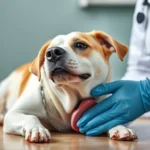
Introduction
Ensuring the health and well-being of our furry friends is a fundamental responsibility of every dog owner. From regular veterinary check-ups to proper grooming, the care we provide significantly influences our dogs’ quality of life. One area that often raises questions is grooming, particularly regarding the products we use. One common inquiry among pet owners is: can you use baby shampoo on dogs?
In this article, we will explore the safety, benefits, and risks of using baby shampoo on dogs. We will also discuss alternatives that may be more suitable for your dog’s grooming needs. By the end of this post, you’ll have a comprehensive understanding of how to keep your dog healthy and happy through proper grooming practices.
Understanding Dog Skin and Coat Health
Anatomy of Dog Skin
To appreciate how grooming products affect our dogs, it’s essential to understand their skin structure. Dog skin comprises three main layers: the epidermis, dermis, and subcutis. The epidermis is the outer layer that provides a barrier against environmental hazards. Beneath this is the dermis, which contains hair follicles, sweat glands, and blood vessels. The subcutis layer provides insulation and cushioning.
A critical difference between dog and human skin is the thickness. Dog skin is generally thicker and has a different pH balance. This makes it more sensitive to certain products that may be safe for human use but could irritate a dog’s skin.
Common Skin Issues in Dogs
Dogs can suffer from various skin conditions, including:
- Allergies: Environmental allergens, food sensitivities, and flea bites can cause itching and inflammation.
- Infections: Bacterial or fungal infections can lead to redness, swelling, and discomfort.
- Parasites: Fleas, ticks, and mites can result in skin irritation and hair loss.
Signs that indicate a potential skin issue include excessive scratching, biting, redness, and unusual odor. Recognizing these signs early can help in seeking appropriate treatment.
Importance of Proper Grooming
Benefits of Regular Grooming
Regular grooming is not just about aesthetics; it plays a crucial role in maintaining your dog’s overall health. Some significant benefits include:
- Skin health: Regular brushing removes dead hair and skin cells, preventing matting and promoting healthy skin.
- Bonding time: Grooming can be an excellent opportunity for bonding between you and your dog, enhancing your relationship.
- Reducing shedding and matting: Consistent grooming helps manage shedding and prevents matting, making your dog’s coat easier to maintain.
Grooming Tools and Products
Having the right grooming tools can make the process easier and more effective. Essential grooming tools include:
- Brushes: Different types for various coat lengths (slicker brushes for long hair, bristle brushes for short hair).
- Combs: Useful for detangling and checking for parasites.
- Dog-specific shampoos and conditioners: Formulated to cater to a dog’s unique skin and coat needs.
Can You Use Baby Shampoo on Dogs?
Composition of Baby Shampoo
Baby shampoo is designed to be gentle and tear-free for infants. The primary ingredients often include water, surfactants, and mild preservatives. While these components are safe for human babies, they may not be optimal for dogs.
In contrast, dog shampoos are formulated specifically for canine skin and coat. They typically include ingredients that maintain the natural oils of the skin and address specific canine issues, such as flea control or allergies.
Safety Considerations
One crucial factor to consider when asking, can you use baby shampoo on dogs? is the pH level. Human skin has a pH of around 5.5, while dog skin is more alkaline with a pH of about 6.5 to 7.5. Using products that are not pH-balanced for dogs can disrupt their skin barrier, leading to dryness and irritation.
Additionally, baby shampoo may contain fragrances and preservatives that could be potential allergens or irritants for some dogs. Always check the ingredient list before using any product on your pet.
Benefits of Using Baby Shampoo
Despite some concerns, there are situations where baby shampoo might be appropriate:
- Gentle formulation for sensitive skin: If your dog has a mild skin reaction to traditional dog shampoos, baby shampoo can be a temporary solution.
- Occasional use: In emergency situations or when dog-specific products are unavailable, baby shampoo can be a last-resort option.
Risks of Using Baby Shampoo
While baby shampoo may seem like a gentle alternative, there are risks involved:
- Possible adverse reactions: Some dogs may experience dry skin or irritation after using baby shampoo, leading to increased scratching or discomfort.
- Long-term effects: Regular use of baby shampoo can strip essential oils from the coat, leading to a dull appearance and potential skin issues.
Alternatives to Baby Shampoo
Dog-Specific Shampoos
There is a vast array of dog-specific shampoos available on the market, designed to cater to different skin types and conditions. Some categories include:
- Hypoallergenic shampoos: Ideal for dogs with sensitivities or allergies.
- Medicated shampoos: Formulated to treat specific conditions like dermatitis or fungal infections.
- Moisturizing shampoos: Beneficial for dogs with dry skin or coat issues.
Always consult with your veterinarian to choose the best shampoo for your dog’s unique needs.
Natural Home Remedies
For pet owners interested in DIY solutions, there are several natural dog shampoo recipes using safe ingredients:
- Oatmeal shampoo: Blend oatmeal with water for a soothing wash that can help with itching.
- Coconut oil shampoo: Mix coconut oil with a little water to create a moisturizing wash.
While natural remedies can be effective, it’s essential to research ingredients thoroughly to avoid any harmful effects.
When to Consult a Veterinarian
If your dog shows signs of skin issues that persist despite regular grooming, it’s best to consult a veterinarian. Symptoms that warrant professional advice include:
- Excessive scratching or biting at the skin.
- Red, inflamed patches or lesions.
- Foul odor or unusual discharge.
A veterinarian can provide tailored recommendations based on your dog’s breed, age, and health status.
Best Practices for Dog Grooming
Frequency of Bathing
The frequency of bathing varies based on several factors, including breed, age, and activity level. Generally, dogs should be bathed:
- Every 4 to 6 weeks: For most dogs, this is sufficient to maintain cleanliness without over-drying the skin.
- More frequently: Active dogs or those that enjoy outdoor activities may require more frequent baths.
- Seasonal considerations: Dogs may need more frequent grooming in spring and summer due to shedding.
Bathing Techniques
To make bath time more enjoyable for your dog, follow these steps:
- Preparation: Gather all necessary supplies, including shampoo, towels, and a non-slip mat.
- Wet the coat: Use lukewarm water to saturate your dog’s coat, avoiding the head initially.
- Apply shampoo: Use a dog-specific shampoo and massage it into the coat, lathering thoroughly.
- Rinse well: Ensure all shampoo is removed to prevent skin irritation.
- Dry: Use a towel to dry your dog, and consider using a blow dryer on a low setting for longer-haired breeds.
Post-Bath Care
Post-bath care is crucial for maintaining your dog’s coat. After bathing:
- Dry thoroughly: Ensure your dog is completely dry, especially in cooler weather, to prevent colds.
- Brush the coat: Brushing helps remove tangles and distributes natural oils.
- Use finishing products: Consider dog-specific conditioners or sprays to enhance coat health.
Additional Health Care Considerations
Regular Veterinary Care
Routine veterinary check-ups are vital to ensure your dog’s overall health. Regular visits help monitor vaccinations, weight, and potential health issues. Common screenings include:
- Blood tests: To check for underlying health conditions.
- Parasite control: Ensuring your dog is protected against fleas, ticks, and worms.
Nutrition and Diet
A well-balanced diet plays a critical role in maintaining your dog’s skin and coat health. Key nutrients include:
- Omega fatty acids: Promote healthy skin and a shiny coat.
- Vitamins and minerals: Essential for overall health, including skin integrity.
Consult your veterinarian for dietary recommendations tailored to your dog’s specific needs.
Exercise and Mental Health
Physical activity is essential for a dog’s well-being. Regular exercise helps:
- Maintain a healthy weight.
- Reduce behavioral issues stemming from boredom or excess energy.
- Promote mental stimulation through interactive play.
Activities like walks, fetch, and agility training can significantly enhance your dog’s quality of life.
Conclusion
In conclusion, while some pet owners wonder, can you use baby shampoo on dogs?, the answer involves considering the unique needs of canine skin. Baby shampoo may provide a gentle alternative in specific situations, but it is generally better to use products designed for dogs. Prioritizing proper grooming practices, including regular bathing with suitable products, will help maintain your dog’s health and happiness.
As responsible pet owners, we must stay informed about the best practices for grooming and overall health care. By doing so, we ensure that our canine companions lead vibrant, joyful lives.









